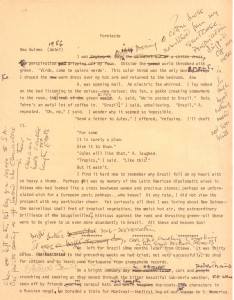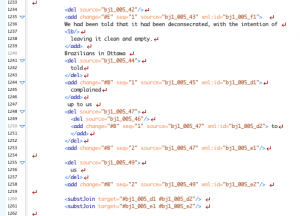Community
March 4, 2014
The Digital Page: Brazilian Journal
I began working with the Brazilian Journal four years ago, when Suzanne Bailey was working on a print-based critical edition of the text for Porcupine’s Quill. Brazilian Journal began as a diary kept by Canadian poet P.K. Page, from 1957-59, while she accompanied her husband to Brazil, where he was serving as Canada’s ambassador. When Suzanne and I began working on the text we were under the assumption that the only existing manuscript was Page’s original diary pages, now stored at the LAC. This situation simplified the editorial task, as we chose the first print edition of the text, published by Lester & Orpen Dennys on June 27, 1987, as our copytext.
Shortly before our new edition went to print, however, we discovered eight heavily annotated typescripts of the Brazilian Journal that showed a very clear evolution of the text from Page’s diary in the late 1950s to the polished text published in 1987. While vastly informative for literary critics studying both the text and Page’s work as a whole, these typescripts presented us with thousands of pages of new material. There was no easy way to present this genesis of the text, with its thousands of variants, in a print edition, and still have it be usable as a clear reading text. Zailig Pollock, as editor of the Collected Works of P.K. Page Project is attempting to create digital editions that do both. His solution is to create two separate, but related, publications: a printed edition, and an online database. The print editions, published by Porcupine’s Quill, are intended for general readers and students, rather than as primary scholarly resources. The online database, however, will display digital facsimiles of every version of the work—both manuscripts and published. The Brazilian Journal was chosen as the first of Page’s texts to undergo this two-pronged approach to a scholarly edition, and we finally have a working prototype of the digital database—what Zailig calls the Digital Page—to share with the wider EMiC community.
The digital database had to meet several requirements. First, it had to display a facsimile of each manuscript page. Second, it had to provide a clear narrative outlining the genesis of each manuscript page, placing all the changes and corrections in chronological order. Third, it had to present a clean reading text. The current prototype does all three of these things. Zailig has written a very useful guide to navigating the database’s interface [click here to read guide].
I thought it would be interesting to quickly show some of the work that went into building this prototype. Thanks to the help of some excellent RAs, we began by scanning all of the eight typescripts at a high-resolution to ensure that they would be readable online. (Each typescript is over 300 pages, so this was not a quick task.) After we had each typescript scanned, we began transcribing each page. We used OCR to help when we could, but often Page’s corrections and marginalia made this impossible. This is the first page of the first manuscript. While it is more heavily marked up than the average page, it does show what we were working with. We have identified five unique “editing sessions” on this page alone.
A session or ‘campaign’ as it is sometimes called represents a self-contained set of revisions. That is, all the revisions identified as being from a single session follow all of the revisions from earlier sessions and precede all of the revisions in following sessions. Within a session the chronological relationship amongst various sets of revisions is usually not obvious. There is no reason, for example to assume that revisions made on the first page precede ones on the last page. In contrast a revision in Session A to the past page of the document will precede all revisions in Session B, including those on the first page. The teasing out of the different sessions is base partly on writing material—pencil or ink of various colours or felt pen, in the case of Brazilian Journal—but other internal, and external evidence can come into play. The digital edition will include a discussion of the sessions and our determination of them.
We have identified six different sessions in the first manuscript. The five shown on the first page are:
A – typescript
B – felt pen
C – blue ink
D – pencil
E – black ink
After transcribing each page, we had to code each page using TEI markup. Zailig developed a very specific set of tags, all of which are TEI compliant, to mark all variants in the text. Alongside this tag-set, we also tagged each “revision site” to its corresponding location on the manuscript page. By doing this, we have linked all revisions in the transcription with the manuscript page itself. This ensures that it is very easy for a reader to understand where a change takes place. (If you look at the prototype, you can see this linking in practice.) A sample of our coding for this first page looks like this:
After coding each page, we run the XML file through an XSLT program designed by Zailig’s son Josh, which outputs the HTML that you can see in the prototype. (If you are interested in learning about XSLT, you should check out the EMiC-sponsored DHSI course being taught this year by Zailig and Josh—“A Collaborative Approach to XSLT.”)
This is a lengthy-process, with the coding of each page taking at least thirty minutes—a page like the one above takes much more. As a result, it will take years to finish this project. But we are aware of this limitation, and have designed the digital database to accommodate this. We currently envision the Digital Page website to post new material as it becomes available. Thus, we will post the scans of each manuscript first. Then we will post the transcriptions, and finally, the coded pages. This will allow scholars to have access to the material before the digital edition is complete.
The prototype is still being in its beta phase. Zailig and I are constantly tweaking the coding when we encounter new problems that we need to solve. Josh is constantly adjusting the XSLT to ensure that the resulting HTML performs as it should. There are two limitations to the interface as it currently stands which we will be working on in future. The first is that currently the user can only move from any revision in the typescript to the image. Josh is currently writing code that will allow the user to move in the other direction, from any revision point in the image to the equivalent point in the transcription. The user will also be able to see at a glance the sequence of the revisions through the various, colour-code sessions. The next step, which is farther down the road, but which does not seem to present any insuperable difficulties, is to allow the user to follow the genesis through all of the relevant documents
If you have any comments or suggestions on our prototype, we would welcome them!


[…] an author wrote and revised her text. The prototype is discussed in further detail in “The Digital Page: Brazilian Journal,” Editing Modernism in Canada (March 4, […]